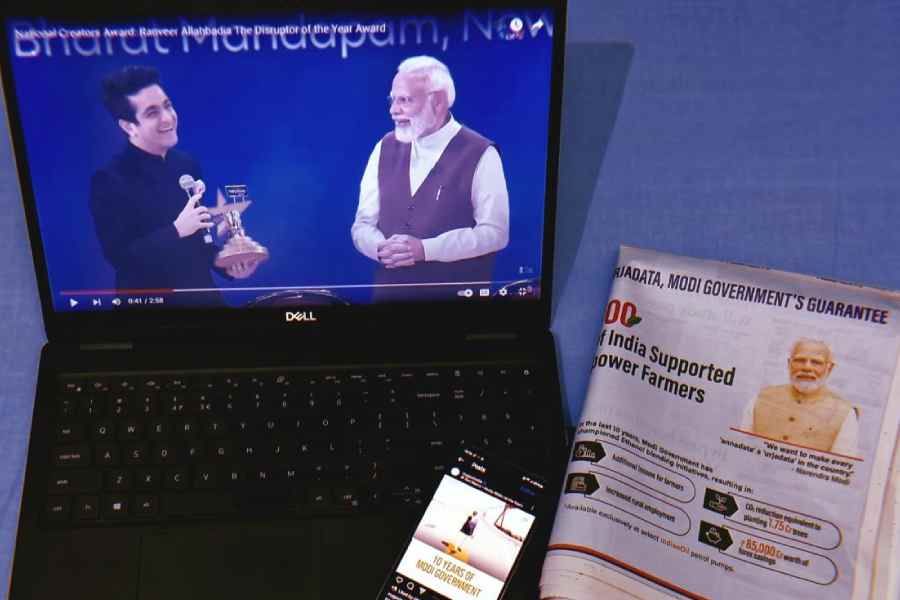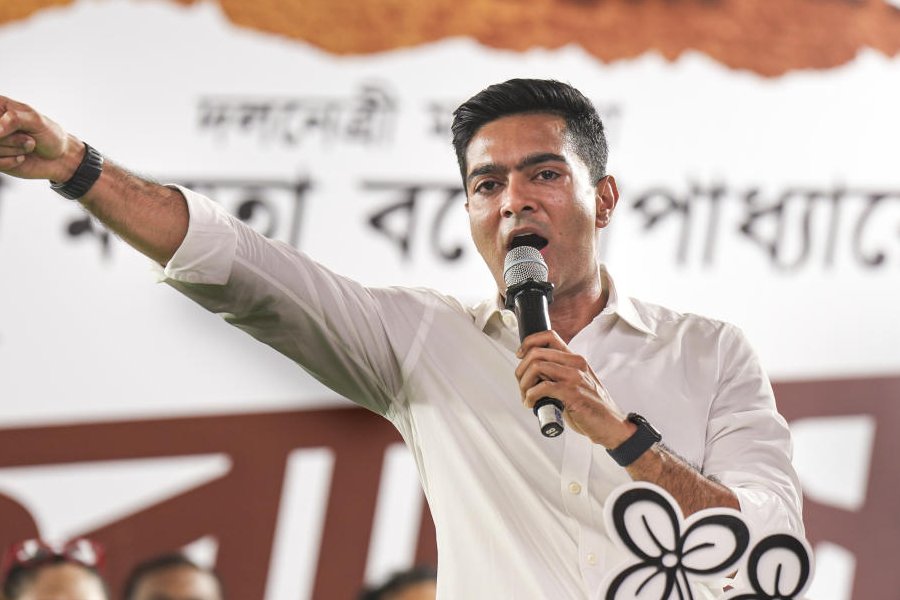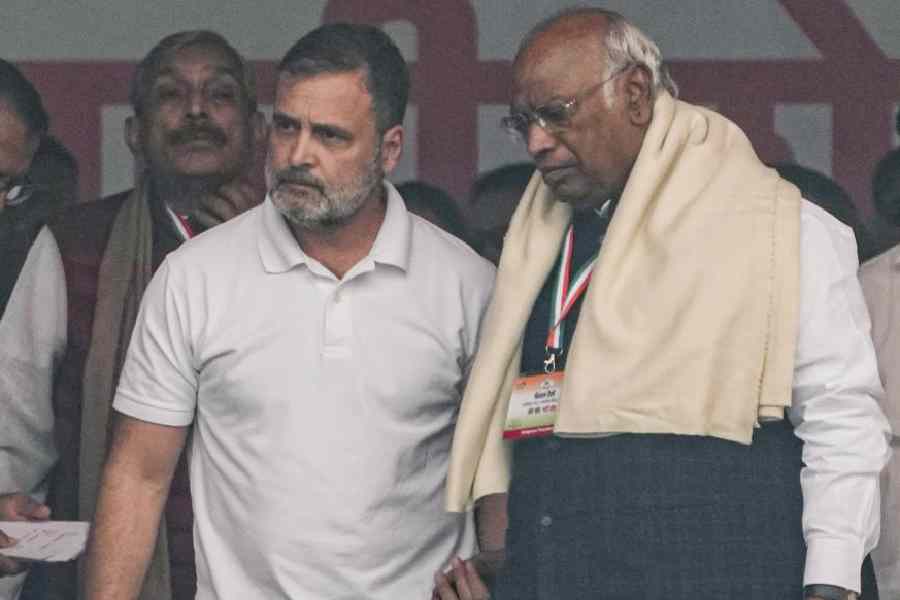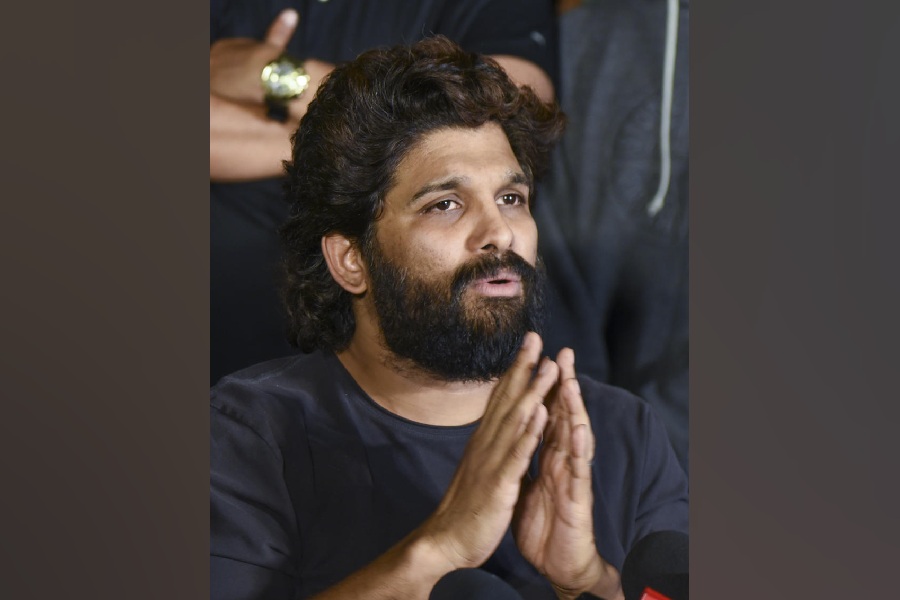If the upcoming elections tell us anything at all about the news media, it is that it has become largely inconsequential during elections. Notions of being the fourth estate may sustain its morale but there are indications all around that the agenda-setting it might want to do will be limited in impact. The political class swamps the media real estate with advertising, and media-owners are so grateful for this that, in terms of visibility, the news often gets short shrift. About the only use that the Narendra Modi government demonstrates for the mainstream media is as a platform for advertising.
The weaponisation of agencies, such as the Enforcement Directorate and the Central Bureau of Investigation, and the use of terrorism laws have taken away the mainstream media’s zeal for trying to hold this government to account. Even the bravest among the media are scared to offend.
The national broadcaster’s role has been redefined to serve the cause of religious majoritarianism. It now does more consequential agenda-setting than ever before, the high point being showcasing the prime minister performing priestly duties at the consecration of the Ram temple in Ayodhya. Last week, Doordarshan was pressed into service to offer a daily telecast at 6.30 am of the morning aarti from the Ram temple in Ayodhya.
What is spent on political image-building is largely unquantifiable. The unfolding electoral bond revelations demonstrate that both the Centre and the state governments have not been shy of extorting from corporates to continue
to win elections. Even a ruling party with considerable public legitimacy in terms of seats held looks to spend unprecedented sums of money in the next few months to continue winning.
The quantum of spending on advertising and other kinds of outreach is evident in the manic frequency of the ‘Modi Ki Guarantee’ advertisements on television, in the manpower deployed for social media outreach to the voter, and in the scale of the disinformation campaigns being mounted. However, since state governments also do a lot of spending which builds the prime minister’s image, it is difficult to compute the overall cost. No realistic estimate of election outreach is possible or available. Except for some of the social media spending, which is small.
Earlier this month, The News Minute reported that data from Google’s Ads Transparency Center showed that the Bharatiya Janata Party had spent Rs 29.7 crore in the 30 days preceding March 1 on streaming ads, mostly videos, which boosted the image of the prime minister, Narendra Modi, and the Union government’s schemes in multiple languages. In comparison, the party had spent Rs 12.3 crore in the four-month period leading up to the general elections in 2019.
The ad spend is matched by censorship and threats. Around the same time, The Global Government Affairs page of X announced that the Modi government has issued it executive orders to withhold specific accounts and posts, failing to do which would attract fines and imprisonment for officials.
Meanwhile, Boom Live reports that a Facebook page called Ulta Chashma and its network of pages has spent over Rs 2 crore “promoting over a thousand ads [with an extra dose of misinformation and hate] on Meta-owned platforms” since November 2023. Boom uses the term, misinformation, but the operation it describes is plainly disinformation. This campaign has four pages targeting states that are not ruled by the BJP: Sonar Bangla aimed at the Trinamul Congress in West Bengal, Tamilakam aimed at the Dravida Munnetra Kazhagam-ruled Tamil Nadu, Kannada Sangamam aimed at Congress-ruled Karnataka, and Malabar Central targeting the Left Democratic Front in Kerala.
These Meta pages also carry disinformation targeting the farmers’ protest, hate speech targeting Muslims and run surrogate ads targeting Opposition leaders. This campaign began last year before the state elections. Social media outreach costs are chickenfeed compared to other activities but they can effectively inject slow poison in the public sphere.
The Hindustan Times published a research study on what worked in the Uttar Pradesh elections of 2022 according to voters. It found that in-person party outreach was judged the most effective, both in terms of rallies and door-to-door contact. This view was held by 73% respondents for small, regional parties and by 54% for large, national level parties. Estimates for party-wise spending on ground rallies are not easy to come by but it is footage from these that are grist for the social media outreach mills by armies of party workers.
The use of WhatsApp for outreach has become a booth-level operation. You have to get the phone numbers of voters — let’s say, 10,000 numbers for a booth or more — and then message them intensively. The HT study shows that it could be around 40 to 50 times a day on an average during election campaigns. In the months after the elections, this dropped to around 15 times a day.
But the in-between period is important for what the former journalist, Ashutosh, calls ‘brainwashing’ the voter. He says that Amit Malviya and the BJP’s IT cell disseminate content which will praise Modi and discredit the Opposition. They send out videos and songs which pack in all their agendas. The human cost of party outreach on such intensive voter contact is, once again, difficult to estimate financially, but these are the sort of costs that feed the insatiable appetite for political funding.
Between 2014 and 2019, the BJP government led by Narendra Modi effectively sidelined the news media. Government personnel were discouraged from briefing the press, the practice of taking journalists on the prime minister’s plane on foreign trips was discontinued, the government turned to the in-house broadcaster, Doordarshan, to meet its publicity needs and Modi and his ministers took to Twitter to make announcements.
More recently, they have discovered the power and the pliability of social media influencers for video outreach. Interviews are increasingly given to them, whereas they were earlier given to pliable journalists. This month, the government announced that it has instituted ‘creators awards’ for social media influencers and no less than the prime minister presented “the first ever National Creators Awards” to influencers for their contribution to nation-building.
Then, government-friendly film-makers are also chipping in with cinematic propaganda. Both this newspaper and Al Jazeera have documented the number of films released or awaiting release and recalled the films that came in handy to queer the pitch for the ruling party in 2019.
Some of the new films are either in the theatres already or will be out soon. Two of these claim to reveal facts about the Godhra train burning in 2002 — Accident or Conspiracy: Godhra and The Sabarmati Report. Another film, Aakhir Palaayan Kab Tak? (Until when will we need to flee?), shows the Hindu “exodus” from Muslim-majority areas, while a third, Razakar, will be a multilingual release on what it calls the “silent genocide” of Hindus in Hyderabad by Razakars before and after 1947. Article 370 was released earlier this year and won praise from the prime minister himself. In 2019, the period just before the elections saw the release of The Accidental Prime Minister, discrediting Modi’s predecessor, Manmohan Singh, and the jingoistic Uri: The Surgical Strike.
How consequential, then, is the news media, irrespective of whether it is friendly or doing its job? And after voters survive the multi-pronged propaganda onslaught, how will they vote? We do not have enough research yet to establish how propaganda works for different classes. But to voters at the lower and bottom end of the pyramid, does it really matter whether members of Parliament and the legislative assemblies are being bought, or if defections are being engineered, or if TV and social media are propagandist, or if the ruling party is being extortionist with the business class? When people are desperate for work and jobs and wage levels are abysmal, they may change their vote this time but, at the next election, it could change again.
Sevanti Ninan is a media commentator and was the founder-editor of TheHoot.org











